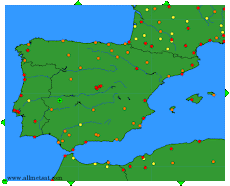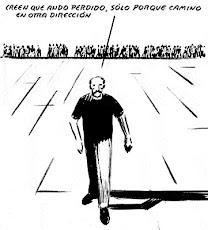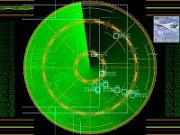jueves, 5 de enero de 2012
SI BEBES NO VUELES, NO CONTROLES Y NO DIRIJAS UN AEROPUERTO
En estas fiestas navideñas, tiempo de excesos para bien y para mal, viene bien recordar cuáles pueden ser las consecuencias de no realizar determinadas actividades en plenas condiciones físicas y mentales: Volar, controlar y dirigir un aeropuerto.
No nos cabe la menor duda que todos los pilotos y controladores realizan su actividad en plenitud de facultades, a pesar de tener en contra a los elementos, las compañías y AENA, que les empujan en sentido contrario. Sin embargo expresamos nuestras dudas que la dirección de algunos aeropuertos en España se lleve a cabo con las máximas garantías de seguridad: safety y security. El Aeropuerto de Madrid-Barajas es un ejemplo, porque no se entiende que persona alguna en plena posesión de sus facultades físicas y mentales permita una operación insegura como la que hay implantada desde noviembre de 1998. Muchos han pasado por el puesto y ninguno tuvo la capacidad, o quizá las ganas o valentía, de implantar una operación segura, aunque ello signifique reconocer una atrocidad técnica que ha costado, a día de hoy, 10.000 Millones de Euros y 154 víctimas mortales.
Adjuntamos el artículo publicado en SKYbrary sobre la inexcusable necesidad de estar en perfectas condiciones físicas y mentales para pilotar una aeronave.
Lifestyle and Adverse Performance Effects (OGHFA BN)
Source: www.skybrary.aero
Background
Flying is a complex task that requires the full cognitive, judgemental and psychomotor capabilities of a pilot. If these abilities are impaired to any extent, safety can be compromised. Many conditions and substances can cause impairment. For example, all humans occasionally have mild illnesses such as colds that can potentially impair their performance. Some people have chronic conditions such as high blood pressure or elevated cholesterol that are not disabling but require the use of medication to control symptoms. Drugs, both prescription and over-the-counter, can relieve symptoms and, perhaps, even cure the illness. Many people routinely drink alcoholic and/or caffeinated beverages. Each of these uses of drugs, as well as other lifestyle activities, can affect flying, particularly on long-range, monotonous flights, impair the pilot’s abilities and compromise safety.
Introduction
This Briefing Note (BN) covers important lifestyle aspects for pilots—illness, the use of medications and drugs, nutrition and eating habits, alcohol and caffeine intake, and exercise. It is information that you can use to assess your own fitness for flight and to know when to seek the advice of your doctor or flight surgeon. Your personal doctor knows your medical condition best and what is most important for your overall health. He or she, however, may not be trained to appreciate the effects of your medical condition or the drugs he/she prescribes on flight risk. Your flight surgeon, on the other hand, may not be familiar with your overall health but is well aware of the consequences of lifestyle decisions on flight safety. You should make sure that both medical professionals have the information they need about you and your lifestyle to advise you properly and to work as a team.
Determining Fitness to Fly
Your doctor and flight surgeon do not see you daily. They depend on you to seek them out when you think you have a health condition. On a day-to-day basis, however, you have to determine if you are fit to fly or should seek medical attention. If you think of the following question and answer, it will help you make a good decision.
Am I fit to fly?” Yes, I‘M SAFE!
Illness: Am I ill? Do I feel sick in any way?
Medication: I take drugs: will they impair my thinking, judgment or performance?
Stress: Am I mentally fit? Can I devote my full attention to flying?
Alcohol: When did I take the last drink? Am I suffering hangover effects?
Fatigue: Am I physically fatigued? Am I too tired to give 100%?
Eating: Am I hungry? Did I eat too much? Do I have indigestion?
This simple mnemonic, I’M SAFE, is a checklist to help you remember the main lifestyle risk factors that might impair your performance during flight.
Data
There are few statistics on the effect of lifestyle on flight safety, but it is universally acknowledged that an impaired pilot is a safety risk. As mentioned earlier, one has to be fit for flying because it is a demanding task.
An example from military flight illustrates the deleterious effect of illness, drugs and fatigue on flight safety. An F-14 Tomcat crashed on the deck of a U.S. aircraft carrier at night killing several of the ship’s deck crew. The pilot had contracted a severe flu and had taken nasal decongestant drops without telling his flight surgeon. These drops have serious negative side effects on performance, particularly visual performance at night.
The Effect Of Drugs On Flight Safety
A drug can be defined as any chemical substance that has an effect on living tissue but is not used for food. Drugs are used on or administered to humans as:
An aid in the diagnosis, treatment or prevention of disease or other abnormal conditions
For the relief of pain or suffering
To control or improve any physiological or pathological condition.
Drugs can generally be classified into two broad categories—licit and illicit. Licit drugs are often referred to as medications, and illicit drugs are sometimes called “recreational” drugs. This distinction can be blurred when drugs that are legal if prescribed by a doctor are used without medical need or authorization.
Alcohol and caffeine are the most widely used drugs. It is legal to consume alcohol in most locales, but the effects of the misuse of alcohol on transportation safety can be enormous. Many everyday beverages and food products such as coffee, cola and chocolate, contain significant amounts of caffeine.
Medicines
All pilots should know that all medications, even those seeming to be “light,” contain active components with desirable therapeutic benefits but also unwanted and often unpredictable side effects. Such side effects can vary widely across individuals depending on personal sensitivities and the pharmacokinetics of the drug. A drug that can relieve symptoms or cure a condition in one pilot may cause a violent and life-threatening allergic reaction in another.
Flight can also alter the effects of medications. For example, the metabolism of a drug may be altered by flight-induced conditions including mild hypoxia, dehydration and jetlag. The undesirable effects of a drug are also sometimes delayed until well after the drug is taken. Care must especially be exercised when a drug is new on the market or taken in combination with other medications because little may be known about the resulting effect on flight safety.
The following table identifies families of widely-used medicinal drugs, both prescription and over-the-counter (OTC), that are known to have negative effects on alertness, sensory performance, judgement, cognitive and/or psychomotor abilities. As such, these drugs, even when prescribed by your personal doctor, may not be compatible with safe flight unless approved by a flight surgeon.
Table available at TABLE.
Note: This table is not meant as a list of drugs for self treatment. It is also not intended to be a comprehensive list of all drugs that can affect flight safety. It is provided to give examples of commonly used medicines that, although beneficial in preventing or curing illness and injury, can be detrimental to the safe performance of a pilot’s duties.
The information in the table above is just a summary to indicate the wide range of medications used today and their possible adverse effects. It must also be remembered that taking medications in combination or with alcohol can change both the nature and intensity of the deleterious effects.
Remember that all medications are potentially dangerous and that you should not fly after intake of a drug unless the flight surgeon has prescribed it or checked its efficacy and tolerability.
Illicit drugs
Many drugs, although illegal to consume or possess, are nevertheless widely used. Other drugs that have legitimate medical uses can be abused if not taken as prescribed by a doctor or taken for non-medical purposes. People seek a “high” or escape from reality by abusing substances such as: Cannabis (marijuana) - not illegal everywhere, Psilocybin mushrooms, Opium
Heroin - illegal in most countries, Cocaine, Morphine, Methamphetamine (meth).
Almost all illicit drug use leads to some level of impairment that is detrimental to safe flight. Illicit drug use is not only dangerous but also can ruin a flying career. As a pilot, you should never use illicit drugs.
Alcohol
Contrary to popular belief, alcohol acts as a depressant not a stimulant. What is often mistaken for mood elevation from alcohol (e.g., loud speech, aggressive behaviour) is actually a result of its disinhibiting effects. As one drinks, alcohol first affects judgement and removes inhibitions and then degrades psychomotor performance.
Blood alcohol concentration (BAC) is the measure typically used to indicate a person’s degree of impairment. BAC is the weight of alcohol in grams per 100 ml of blood. The time for a person to reach a peak BAC after consuming alcohol varies depending on the rate of absorption of the alcohol into the bloodstream. This absorption rate can be influenced by body build and size, age, gender (females tend to be affected more than males), whether food has been taken with the alcohol and the type of drink.
On average, alcohol is eliminated from the body at the rate of about one standard drink (a BAC of about 0.03) per hour. However, the elimination rate of alcohol can vary greatly by individual depending on factors such as gender, body mass and drinking frequency.
Various BAC levels have been used to define when someone has consumed too much alcohol and therefore is unfit for some activity. For example, a BAC of 0.08 (0.08 grams of alcohol per 100 ml of blood) is used in all 50 of the United States to define a level of intoxication at which it is illegal to drive a car. Many other countries define even lower BAC limits for drivers.
Most countries and airlines have a bottle to throttle rule specifying how much time must elapse from the last drink until a pilot flies. The typical value is 8 hours, although some rules specify 10 or 12 hours. There are also BAC limits for flying, which typically are zero (0.00) or 0.02. An important point for a pilot to note is that alcohol can be impairing even after your BAC returns to zero. Anyone who has ever experienced a hangover can tell you that. Thus, while a nice cocktail and glass of wine at dinner before a noon departure the next day is probably fine, more extensive drinking can significantly increase safety risk even if your BAC is zero when you get to the cockpit.
All of the available scientific evidence shows conclusively that any alcohol use causes impairment with the nature of the effects being dose dependant. At BACs below 0.03, euphoria and some impairment of judgement are evident. As BAC increases above 0.03, functions such as divided attention, choice reaction time, visual perception, tracking and steering, eye movement control, standing steadiness, emergency responses, coordination and information processing judgment have been shown to be significantly impaired. Above a BAC of about 0.05, lack of coordination and problems with gross motor control occur. Although sleep is promoted by alcohol because of its sedative effect, it can also actually impair sleep quality and even cause insomnia.
Alcohol, when consumed in excess amounts, has a wide range of short- and long-term ill effects on an individual's health. Alcohol causes inflammation of the stomach, pancreas, and intestines, which impairs the digestion of food and absorption into blood. Moreover, acetaldehyde (the oxidation product of alcohol) can interfere with the activation of vitamins. Alcohol has a high caloric value; hence it can lead to weight gain when consumed in large quantities. It also causes low blood-sugar levels and dehydration, leading to an increase in appetite.
Caffeine
Caffeine is a stimulant that is contained in many beverages, foods and OTC drugs. The use of caffeine can prevent falling asleep, but it does not necessarily improve performance. The performance of a person who is not significantly fatigued but may be bored or otherwise drowsy from lack of stimulation, can possibly benefit from the stimulant effects of caffeine. On the other hand, a grossly fatigued individual may be kept awake by large dose of caffeine but will still exhibit impaired performance.
Pilots can effectively use caffeine from coffee or tea on long-range flights if they time its intake appropriately. Advice on when to schedule caffeine intake can be found in the Briefing Note How to Cope With Jet Lag in Eastward and Westward Rotations. It must be remembered, however, that caffeine is a drug with possible negative side effects such as insomnia.
Also, there have been reported cases of people taking toxic doses of caffeine in an effort to stay awake.
Some myths about drug use
OTC drugs are not dangerous.
Wrong! Any drug, even a vitamin or herb, can be dangerous and can interfere with safe flying. Many of the drugs in the table above can be purchased without a prescription.
If I take a medication well before the time of flight, it will not impair my ability.
Wrong! While some drugs only produce effects for a few hours, many have long-lasting effects. Do not assume the deleterious effects are gone just because your last dose was hours before the flight. Ask your flight surgeon how long you should wait before flying after taking a prescription or OTC drug.
I can take a medication that has been prescribed to another member of my family or a friend suffering from the same symptoms.
Wrong! The same symptoms can be related to different conditions, and each person may react to a given drug differently.
The first few doses of the medicine I was prescribed did not cure my problem. I think I should double the dose or add another medicine.
Wrong! There is an optimal dose for all medicines. Increasing the dose without a flight surgeon’s permission can be dangerous to your health and might impair your piloting abilities. Combinations of drugs can produce unpredictable reactions. Always check with your flight surgeon before mixing medicines.
A little use of illicit drugs is not dangerous as long as I do it well before flight.
Illicit drugs are dangerous to your health and your career. First, you never really know what is contained in drugs purchased illegally. You could be getting anything—even a dangerous poison. Second, the traces of some drugs such as marijuana, can remain in your system for days or even weeks and will be detected by drug tests.
Nutrition and Eating Habits
Fatigue results in part from a decrease in the stock of carbohydrates (glucose) in the body. There are few studies about the specific relationship between nutrition status and the physical performance level of a pilot during a long-haul flight. Nevertheless, it is reasonable to conclude that eating habits and their impact on nutrition can be related to pilot performance and safety.
The energy expenditure of a pilot during a long-haul flight can be estimated at 200 kilocalories per hour (kcal/h). Since the stock of carbohydrates in a typical human provides a storehouse of about 2,500 kcal, the desired glucose blood concentration (glycemia) can be maintained for approximately 8-10 hours between two meals for a man strictly at rest. However, even light physical or mental effort increases the body’s need for glucose. Thus, even for a nominal workload of 150 kcal/h the stored glycemia begins to be used up in four to five hours without eating, resulting in decreased cognitive performance and fatigue.
Based on this simple example, it is reasonable to conclude that food intake is necessary after three or four hours of flight.
In addition to maintaining a sufficient stock of glucose, mental performance must also be maintained by an appropriate nutritional approach and timing. For a normally alert and rested person, the intake of fast (sweets) or slow (potatoes, cereal) release carbohydrates leads to a decreased level of alertness 30 to 60 minutes after intake. Thus, taking carbohydrates, while favorable to physical performance, can lead to a decreased level of cognitive performance. By contrast, a meal rich in proteins (meat, fish, eggs, milk derivatives) seems to improve the cognitive performance of those who are fatigued.
These considerations of nutritional physiology lead to the following principles to follow when flying long-haul flights:
The crew should begin a long-haul flight with a high stockpile of energy from a meal consumed sufficiently long before the flight that it will not induce any drowsiness. The optimal intake is about 800 kcal one hour before the flight that includes 50% slow release carbohydrates, 30% fats and 20% proteins
If the flight will last more than three hours, food intake should be scheduled during the flight. The energy bars often taken by athletes are not an appropriate substitute for more balanced food intake because they are too rich in carbohydrates.
It is also important to drink water during the flight to avoid any decrease in performance and vigilance due to dehydration.
After the flight, it is important to eat a meal to recover a good level of performance and alertness.
Some typical menus that will help you follow these principles are shown below.
Before a Flight
Dinner the day before the flight: "spaghetti party" with 100-150 g of pasta (or potatoes) with white meat (chicken, veal or fish). A cream-based dessert.
Just before the flight (at any time of the day or the night): easily digestible foods rich in calories such as eggs, cheese, white meat, buttered bread, cereals and milk. Drink 250-300 ml of water. Avoid fresh fruits, pastries, cream-based desserts.
During a Flight
Flights over two hours: eat a light snack
Flights up to four hours: 2 cereal-based energy bars can be eaten. Avoid the “high-energy” sports bars. Rehydration with water is not necessary if sufficient water was drunk before the flight.
Flights over four hours: Small snacks should be eaten every two hours after the initial two hours of flight. Consume at least 250 ml of water every four hours.
After a Flight
Eat a small snack (600-800 kcal) followed later by a “real” meal
Physical Exercise
Regular physical exercise improves tolerance to environmental stressors in aeronautics and decreases the duration of post-flight recovery. Three one-hour sessions per week or 15-minute daily workouts are recommended. To improve general physical fitness, all types of endurance activities (e.g., cycling, swimming, jogging, tennis) are recommended. To improve piloting performance (and to avoid any back or neck pain), physical training should focus on the postural muscles (cervical, back, abdominal and thigh muscles).
Just prior to a flight (about 10 minutes) you should “wake up” your muscles in order to avoid any muscular tension while on board. Muscular stretching during the flight is also beneficial. Following a flight, stretching exercises can be very beneficial. However, it is best to wait two hours after landing before engaging in endurance types of exercise for relaxation or fitness.
If your flight is scheduled in the morning, engage in endurance exercise at the end of the day. The reverse is not true, however, if you are scheduled for an afternoon flight. When flying afternoons, you should refrain from strenuous exercise that morning.
Summary of Key Points
Safe piloting requires a fully capable individual. No level of impairment is acceptable.
Almost all drugs, whether OTC or prescribed, can impair one or more aspects of flying skills.
Your personal doctor knows your overall health but may not be familiar with the demands of flight. Always crosscheck any prescribed medicines with your flight surgeon.
Alcohol is a drug that can be dangerous to flight even after it is out of your system.
Caffeine can be useful if its intake is properly managed.
Illicit drug use is not compatible with safe flight, your health or your career goals.
Good nutrition can improve your alertness and performance. Eat right and at the correct times.
Exercise, if properly timed, promotes better piloting performance and good health.
Do not fall prey to popular myths about drug use.
Before flying, assess your fitness by remembering to go through the I’m Safe checklist (Illness, Medication, Stress. Alcohol, Fatigue, Eating).
References and Related SKYbrary Articles sections were not included but are available in the SKYbrary article.
Suscribirse a:
Enviar comentarios (Atom)

















No hay comentarios:
Publicar un comentario